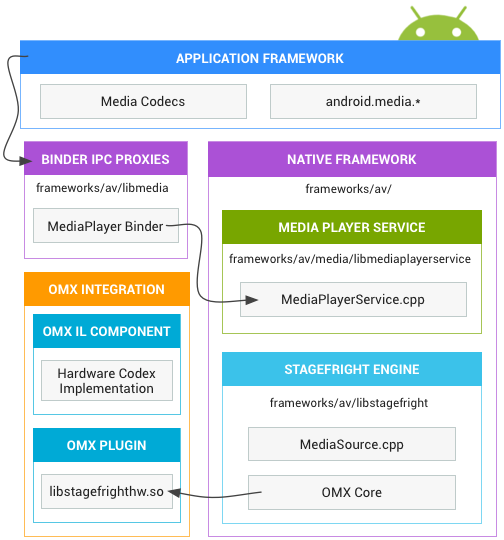Media
Android provides a media playback engine at the native level called Stagefright that comes built-in with software-based codecs for several popular media formats. Stagefright features for audio and video playback include integration with OpenMAX codecs, session management, time-synchronized rendering, transport control, and DRM.

In addition, Stagefright supports integration with custom hardware codecs that you provide. There actually isn’t a HAL to implement for custom codecs, but to provide a hardware path to encode and decode media, you must implement your hardware-based codec as an OpenMax IL (Integration Layer) component.
Architecture
The following diagram shows how media applications interact with the Android native multimedia framework.

Figure 1. Media architecture
Application Framework
At the application framework level is the app’s code, which utilizes the android.media APIs to interact with the multimedia hardware.
Binder IPC
The Binder IPC proxies facilitate communication over process boundaries. They are located in the frameworks/av/media/libmedia directory and begin with the letter “I”.
Native Multimedia Framework
At the native level, Android provides a multimedia framework that utilizes the Stagefright engine for audio and video recording and playback. Stagefright comes with a default list of supported software codecs and you can implement your own hardware codec by using the OpenMax integration layer standard. For more implementation details, see the various MediaPlayer and Stagefright components located in frameworks/av/media.
OpenMAX Integration Layer (IL)
The OpenMAX IL provides a standardized way for Stagefright to recognize and use custom hardware-based multimedia codecs called components. You must provide an OpenMAX plugin in the form of a shared library named libstagefrighthw.so. This plugin links your custom codec components to Stagefright. Your custom codecs must be implemented according to the OpenMAX IL component standard.
Implementing Custom Codecs
Stagefright comes with built-in software codecs for common media formats, but you can also add your own custom hardware codecs as OpenMAX components. To do this, you need to create OMX components and also an OMX plugin that hooks together your custom codecs with the Stagefright framework. For an example, see the hardware/ti/omap4xxx/domx/ for example components and hardware/ti/omap4xx/libstagefrighthw for an example plugin for the Galaxy Nexus.
To add your own codecs:
Create your components according to the OpenMAX IL component standard. The component interface is located in the frameworks/native/include/media/OpenMAX/OMX_Component.h file. To learn more about the OpenMAX IL specification, see the
OpenMAX website.
Create a OpenMAX plugin that links your components with the Stagefright service. See the frameworks/native/include/media/hardware/OMXPluginBase.h and HardwareAPI.h header files for the interfaces to create the plugin.
Build your plugin as a shared library with the name libstagefrighthw.so in your product Makefile. For example:
LOCAL_MODULE := libstagefrighthwIn your device’s Makefile, ensure that you declare the module as a product package:
PRODUCT_PACKAGES += \
libstagefrighthw \
...Exposing Codecs to the Framework
The Stagefright service parses the system/etc/media_codecs.xml and system/etc/media_profiles.xml to expose the supported codecs and profiles on the device to app developers via the android.media.MediaCodecList and android.media.CamcorderProfile classes. You need to create both files in the device/// directory and copy this over to the system image’s system/etc directory in your device’s Makefile. For example:
PRODUCT_COPY_FILES += \
device/samsung/tuna/media_profiles.xml:system/etc/media_profiles.xml \
device/samsung/tuna/media_codecs.xml:system/etc/media_codecs.xml \See the device/samsung/tuna/media_codecs.xml and device/samsung/tuna/media_profiles.xml file for complete examples.
Note: The element for media codecs is no longer supported by Android starting in Jelly Bean.






















 625
625

 被折叠的 条评论
为什么被折叠?
被折叠的 条评论
为什么被折叠?








